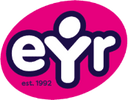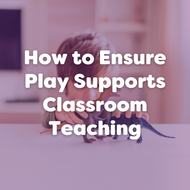How to Ensure Play Supports Classroom Teaching
Posted by EYR Team on 11th Nov 2019
read more
Play is one of the most important ways in which young children gain essential knowledge and skills
The Lego Foundation in Support of UNICEF, 2018, Learning Through Play
‘Imaginative Play’ and ‘Pretend Play’ are often referred to in relation to Early Years and the EYFS. But after children take that leap away from nursery and towards Primary School, does play disappear from their education altogether? Of course not! Play has been proven to be crucial for Foundation and KS1 development, helping to develop fundamental skills such as communication, and supporting curriculum subjects such as Language and Literacy and Maths and Numeracy.
So how can we ensure that play enhances learning, and isn’t a ‘filler’ during the day?
1. Planning
One way to ensure play supports the curriculum is obvious, but essential; planning! This means laying out exactly how imaginative play can support learning can allow for easy implementation and observation.
For example:
Your theme for the week is Dinosaurs. You know that during the week you will be relating the topic to subjects including Literacy, Maths, Science, Geography and Art. If you have an idea of what you want to explore in relation to these topics, take it a step further and apply an imaginative play activity to support this primary activity:
Literacy activities
- Create info sheets about a type of dinosaur and label the picture
- Put together a survival kit for living with dinosaurs
- Creative writing about living with a dinosaur
- Write a diary entry about travelling back in time to when dinosaurs existed
Imaginative play suggestion: why not split into dinosaurs and explorers and act out a tale of discovery
For subjects such as literacy, the imaginative play activity supports the primary activity (creative writing) by giving children time to use their imaginations, find inspiration from class discussions and also their classmates. It makes an activity that may otherwise be considered ‘boring’ (writing) become a way to express themselves and their thoughts independently from the rest of the class.
2. Ask Questions
One way to keep everything on track is to ask questions. For every play activity, make sure you have a list of questions on hand to flick through to help ensure the activity is relating to the primary subject. For example, when children are being dinosaurs, you could ask questions focused towards Science such as;
- What features do all dinosaurs have?
- What are the differences between types of dinosaurs?
- What are the main differences between humans and dinosaurs?
- How do they compare to your pet at home?
- What problems would there be if they existed today?
- Can you work out what Carnivores, Omnivores and Herbivores are?
As questions are asked the ‘dinosaurs’ can act out the new knowledge learnt, making the topic more engaging and more memorable – adding a new dimension to learning.
Make sure you let the children lead the discussions and be flexible with questions; let them discuss and talk about what they find interesting, encouraging their imaginations and creativity.
3. Review
If you’ve taken the time to plan, then you should also take the time to review! Were the children receptive to the imaginative play activities? Did they end up being a bit forced? What would you do differently?
Assessing how well play was incorporated into a class is crucial for its success and ensuring play supports your classroom activities. After all, the main function of play in the classroom should be to enhance teaching, not detract from it! It should never be forced, and should be adaptable; if children aren’t enjoying it, move on or change it.
In essence, imaginative play should provide children the opportunity to express and demonstrate what they have learnt or what they are learning. It should be an enjoyable activity which makes a topic more engaging and helps children gain positive attitudes towards the classroom and each other.
Sources:
‘Learning Through Play’, The Lego Foundation in Support of UNICEF, 2018.
‘Play-based learning can set your child up for success at school and beyond’, The Conversation, 2018.
Why not browse some Imaginative Play Resources to see what works for your setting? Small world play or puppets could be used effectively alongside curricular teaching, or why not try to incorporate a spot of role play and dressing up in your lessons to see the impact this has!



